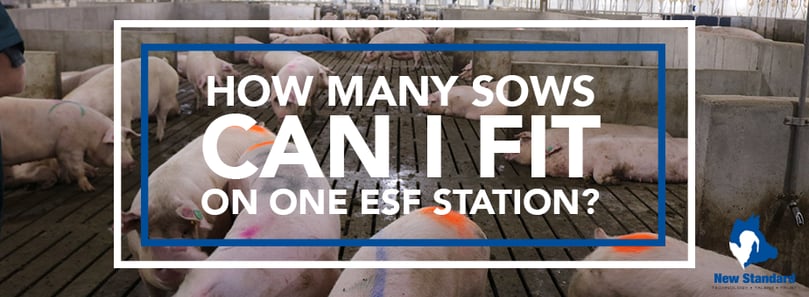
This is often one of the first questions we are asked when talking through an ESF group gestation pen design. We completely understand the importance of this question because as producers, you have to monitor your overhead and operating costs closely in order to turn a profit. While there is significant importance behind this question, we challenge everyone to not only focus on the costs in your barn, but also the impact each aspect of your barn has on your production totals. Learn more on how to calculate the value each of your ESF stations add to your production.
Issues With Focusing on Capacity
It is a common urge to want to put as many sows as possible on an Electronic Sow Feeding station. After all, this should reduce the number of stations you include in your group gestation pen design, thereby reducing the overhead and operating costs in your barn. In practice, the value of each ESF station is more complicated. At a certain point, the more sows you add to a station, the fewer live born piglets each sow will likely produce. No matter how large your pens are, adding too many sows per station causes ever increasing stress and competition among the group during feeding times. The stations will be backed up and the girls waiting will jostle for position until the stations open up for the next pig. Prolonged exposure to this stress will build up and can significantly reduce your birth rates.
Focus on Piglets, Not Sows
Instead of focusing on the number of sows per station, we need to be calculating the number of piglets weaned per station. From our experience with previously designed barns, we have found that there is a point when adding more sows per station increases your feed costs without making an equal or greater impact on your total production. See the following example for the reasoning behind this.
Example
Let's say you have one pen with 45 sows per ESF station and another with 80 sows per station. If the 45 sows average 32 piglets each per year, and the 80 sows only average 28 piglets each per year, you might have more overall piglets, but since each sow is producing less, your cost per piglet is skyrocketing.
45 sows x 32 piglets each = 1,440 piglets per year
80 sows x 28 piglets each = 2,240 piglets per year
In this example, you have 78% more sows per feed station but you have only increased your piglet production by just 56% per ESF station.
Now, we do understand that extra equipment costs more money, but your barn does have limited space. In the scenario above, if you have a 5,500 head sow barn, and you design for 80 hogs per ESF station, your barn would produce 154,000 total piglets per year. If in the same barn you design for only 45 sows per station on average, that same barn has definite potential to produce 22,000 more piglets each year for the same feed cost.
5,500 x 28 = 154,000 piglets per year
5,500 x 32 = 176,000 piglets per year
Sometimes, the better way to save money is to invest more into equipment to reduce the stress among your sows and increase birth rates than to put as many sows on an ESF station as possible. In our design experience, we have found the best target to be between 45 – 52 sows per ESF station, and if the hog barn design has separate gilt pens, they should have between 40 – 45 gilts per station.
Farrowing Crates Are the Most Expensive Place on the Farm
We know that the farrowing crate is the most expensive space in any barn construction and operation. We have already shown that if you increase the number of sows per station beyond recommended limits, you will most likely decrease the number of piglets per sow. That means you will need more sows to meet your production goals or you will have to lower expectations. If you raise the number of sows and farrowings per week, you will in turn also increase the number farrowing stalls you need to construct in order to achieve the same amount of production as if you had fewer sows per station. If you can lower your number of farrowings per week or increase overall piglet production by adding more ESF stations, you are going to increase profitability in the most expensive part of your barn.
The numbers used in this example are taken from general observations of current operating ESF Barns. We recognize that each barn is unique and will produce different results. When we sit down to put together a hog barn design, we take into consideration all of the different variables that come into play in each production. Each barn is a custom design to fit the needs of each producer and their barn staff.





